History of Glacial Varve Chronology: Gerard De Geer and the Swedish Time Scale
Gerard De Geer (1858-1943), Univ. of Stockholm
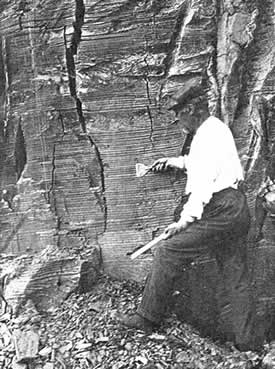
Gerard De Geer at Essex Junction, VT in 1920(from De Geer, 1940)
A Swedish geologist, Gerard De Geer, is generally recognized as the founder of varve chronology. Although De Geer is not the first person to realize the annual nature of glacial varves he is generally credited with being the first person to assemble a chronology using varves and then use it to solve stratigraphic problems. Beginning in 1882, De Geer and his students began to assemble a varve record from south-central Sweden. These sequences would eventually grow, and with later corrections and additions, become the Swedish Varve Chronology or Swedish Time Scale (De Geer, 1912). Today the Swedish Varve Chronology (Cato,1985; Stromberg, 1989) spans from the present back to more than 13,000 yr BP. It is clear, however, that there are probably gaps in the sequences of central Sweden from 5000-2000 yr BP (Wohlfarth et al, 1997) and the chronology likely extends back to about 14,000 yr BP with minor breaks.
The Swedish Varve Chronology
Shown below are the spans of time of various parts of the Swedish Varve Chronology or "Swedish Time Scale". The map shows the approximate locations of the measured sequences of the original "Classical" chronology of Gerard De Geer and Ragnar Lid�n that was formulated in the early 20th century. Later revisions and additions are shown in orange. The Fennoscandian moraines represent deposition during the Younger Dryas Event.
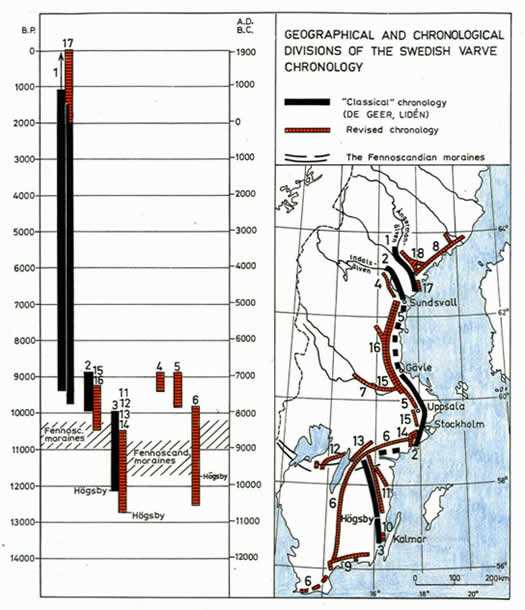
Swedish Time Scale (from Stromberg, 1989).
De Geer and his students not only assembled varve sequences in Sweden but also in other parts of Europe, North America, South America, and Africa. Beginning in the 1920's De Geer tried to make correlations, which he called "telecorrelations" between varves in Sweden and these other parts of the world, which was his major motivation for investigating localities In North America. Today it seems that the exact correlation of varve records between widely-spaced continents, some in different hemispheres, is something that cannot be supported given the varied behavior of annual weather patterns world-wide. Shown below are some of De Geer's attempted correlations of varves in Sweden and the northern Connecticut Valley of New England (De Geer, 1921)
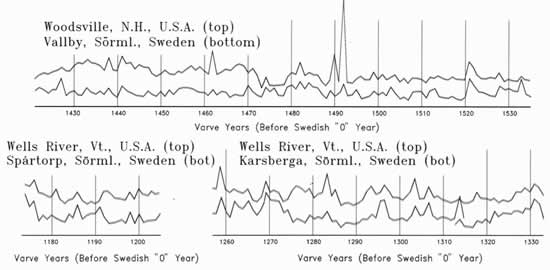
Sweden - New England Correlation Attempt, Replotted from DeGeer (1921).
Gerard De Geer in North America
Taking advantage of contacts at Columbia University and Dartmouth College, Gerard De Geer assembled an expedition to North America in 1920 in an attempt to assemble a large independent varve sequence that would overlap the Swedish Varve Chronology. This effort began the history of varve chronology in North America.
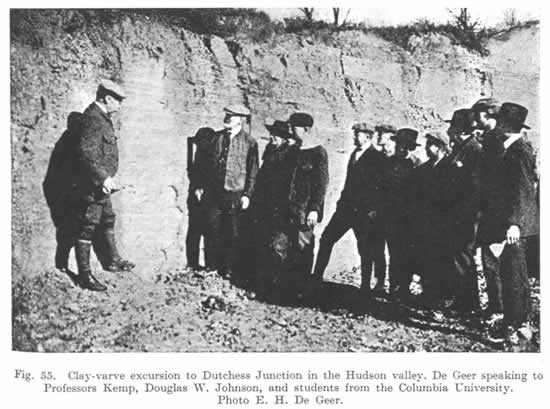
From De Geer, 1940.
The Swedish Geochronological Institute
In 1924 Gerard De Geer established the Swedish Geochronological Institute at the University of Stockholm. The institute was a collection of varve cores, records, and data that is currently housed in the Geo-Science Building (Geovetenskapens hus) at the University of Stockholm.
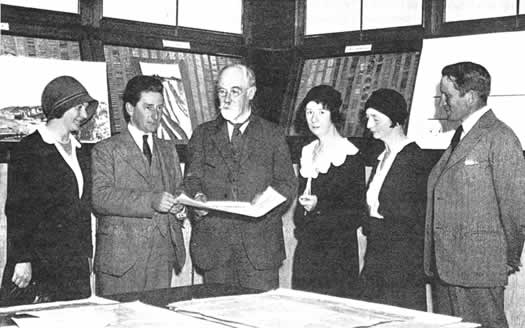
From De Geer, 1940.
References
- Cato, I., 1985, The definitive connection of the Swedish geochronological time scale with the present, and the new date of the zero year in D�viken, northern Sweden: Boreas, v. 14, p. 117-122.
- De Geer, G., 1912, Geochronologie der letzten 12,000 Jahre: Geologische Rundschau, Zeitschrift fur allegemeine Geologie, v. 3, p. 457-471. translated in De Geer, G., 1912, A geochronology of the last 12000 years: Compt. Rend. 11e Congr. G�ol. Internat., Stockholm, v. 1, p. 241-253. (reprinted in Goldthwait, R.P., ed., 1975, Glacial Deposits, v. 21, Benchmark Papers in Geology: Stroudsburg, Pennsylvania, Dowden Hutchinson and Ross, p. 432-440.)
- De Geer, G., 1921, Correlation of late glacial annual clay-varves in North America with the Swedish time scale: Geologiska Foreningens i Stockholm Forhandlingar, v. 43, h. 1-2, p. 70-73.
- De Geer, G., 1940, Geochronologia Suecica principles: Kungl. Svenska Vetenskapsakademiens Handlingar, Tredje Series, Band 18, no. 6, 357 p. and Atlas of plates.
- Stromberg, B., 1989, Late Weichselian deglaciation and clay varve chronology in east-central Sweden: Sveriges Geologiska Undersokning, Series Ca 73, 70 p.
- Wohlfarth, B., Bj�rck, S., Cato, I., and Possnert, G., 1997, A new middle Holocene varve diagram from the River �ngerman�lvan, northern Sweden: indications for a possible error in the Holocene varve chronology: Boreas, v. 26, p. 347-353.


